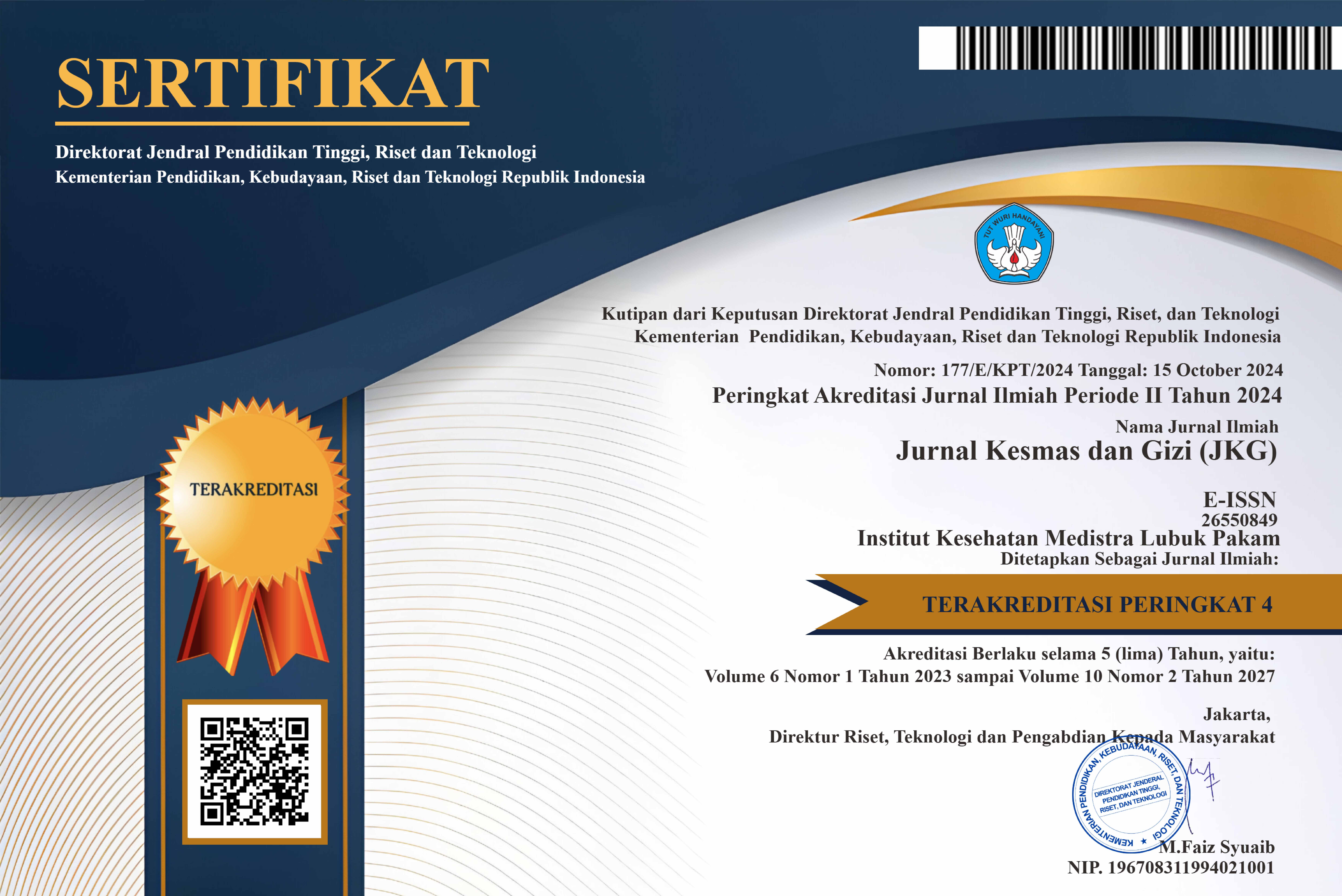THE RELATIONSHIP OF TUMMY TIME WITH NORMAL BABIES' GROSS MOTOR DEVELOPMENT IN THE DENPASAR ASI COMMUNITY IN 2022
DOI:
https://doi.org/10.35451/jkg.v6i1.1933Keywords:
Tummy time, early stimulation, infant's gross motor developmentAbstract
Introduction: Infant motor development is crucial because it bridges the movements that occur during life, produces perceptual information, provides a means to gain knowledge about the world, and allows social interaction. If the basic motor stage is not passed, then there will be obstacles in motor development. Early stimulation will be needed to optimize the growth and development of children according to their stages naturally. Tummy time is one obvious form of early stimulation for muscle tone, posture, and later development. Objective: To determine the relationship between tummy time and gross motor development of normal infants in the breastfeeding community in Denpasar. Methods: An observational study using an analytical cross-sectional study, involving 30 respondents from the breastfeeding mother community in Denpasar. Primary data was obtained through a google form using the WhatsApp blast. Data analysis used Spearman rank correlation test. Results: Showed a significant relationship between the variable doing tummy time and the variable gross motor development sitting in normal infants, whether it was seen from the strong or not the correlation (with very strong results because the correlation coefficient was close to 1), the significance of the correlation results was 0.000 (less than 0.01 and 0.05) and the direction of the correlation is positive. So, Ho is rejected and H1 is accepted. Conclusion: Tummy time is proven to have a close relationship with the achievement of normal infant gross motor development with reference to the ability to sit at the age of six months. Based on the results of the study, it is recommended to do tummy time as a form of stimulation to achieve gross motor development of babies that the public needs to know.
Downloads
References
Adamovi?, T. et al. (2020) ‘Head righting reflex in newborns as the predictive factor of early child development: a longitudinal study’, Early Child Development and Care, 0(0), pp. 1–13.
Ljunghammar Ekberg, T. 2015. Manual Motor Development in Infancy. Execution and Observation of Actions. Digital Comprehensive Summaries of Uppsala Dissertations from the Faculty of Social Sciences 119. 99 pp. Uppsala: Acta Universitatis Upsaliensis.
Hartinger et al. (2017). “Impact of a child stimulation intervention on early child development in rural peru”, J Epidemiol Community Health s And Midwifery Indonesia, hal. 218-224.
Hewitt, L. et al. (2020) ‘Tummy time and infant health outcomes: A systematic review’, Pediatrics, 145(6). doi: 10.1542/peds.2019-2168.
I Made Bakta. (2021) Metodologi Penelitian Kedokteran Dan Kesehatan. Jakarta: PT. Bali International Press. Pp.65-73.
KN, V. (2014) ‘Cerebral Palsy and Early Stimulation’, Cerebral Palsy and Early Stimulation, (July).
Novella J. Ruffin, Ph.D., Assistant Professor and Extension Child Development Specialist, Virginia State University, V. D. of E. L. S. P.and N. (2009) ‘Understanding Growth and Development Patterns of Infants’, Publication 350-055, (350–055), p. 1.
Okely, A. D. et al. (2017) ‘A collaborative approach to adopting/adapting guidelines - The Australian 24-Hour Movement Guidelines for the early years (Birth to 5 years): An integration of physical activity, sedentary behavior, and sleep’, BMC Public Health, 17(Suppl 5).
PH, L., Hermanto and Pranita (2019) ‘Karakteristik Orang Tua Dan Perkembangan’, Jurnal Kesehatan, 12, pp. 1–13.
Ruffin, N. J. (2019) ‘Human Growth and Development - A Matter of Principles’, Virginia Cooperative Extension, 350–053.
Russell, D. et al. (2019) ‘Prone positioning and motor development in the first 6 weeks of life’, South African Journal of Occupational Therapy, 39(1), pp. 11–14.
Soetjiningsih. 2013. Perkembangan Anak dan Permasalahannya dalam Buku Ajar I Ilmu Perkembangan Anak Dan Remaja. Jakarta:Sagungseto .Pp 86-90
Suwarba, IGN, Widodo, DP, Handryastuti, RAS, 2018, ‘Profil Klinis dan Etiologi Pasien Keterlambatan Perkembangan Global di Rumah Sakit Cipto Mangunkusumo Jakarta’, Sari Pediatri, vol. 10, no. 4, pp. 255-261.
Wentz, E. E. (2017) ‘Importance of initiating a tummy time intervention early in infants with down syndrome’, Pediatric Physical Therapy, 29(1), pp. 68–75.
Downloads
Published
Issue
Section
License
Copyright (c) 2023 Arfah May Syara, Endah Sulistiyani, Sabirin Berampu, Anita Sri Gandaria Purba

This work is licensed under a Creative Commons Attribution 4.0 International License.
Copyright in each article is the property of the Author.


























